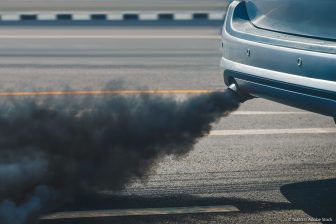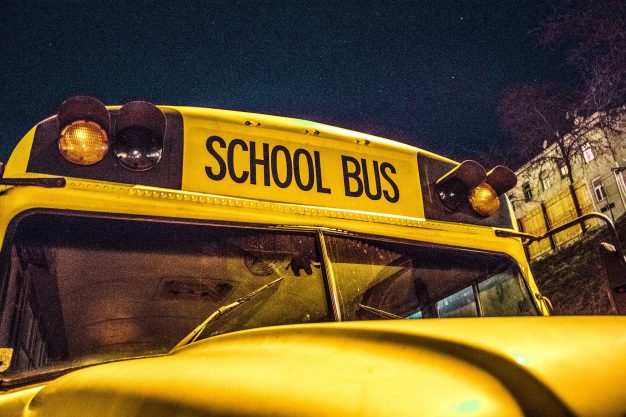
The state of electric school bus adoption in the USA
There are nearly half a million school buses in the United States that transport more than 20 million children to and from school. Some 95 per cent of these school buses run on diesel, a known carcinogen, with air pollution inside buses up to 12 times higher than ambient levels.
Daily exposure for children, who are especially susceptible, contributes to asthma and respiratory diseases as well as cognitive impairment, harming test scores and attendance.
Students from low-income communities are particularly exposed: 60 per cent of students from low-income families ride the bus to school, compared to 45 per cent of students from families with higher incomes, write Leah Lazer, Lydia Freehafer, Jillian Neuberger and Jesse Worker, of TheCityFix.
Moreover, communities of color are more likely to suffer from vehicle-based air pollution due to historically racist lending, transit, housing and zoning policies that concentrated black and brown communities closer to highways and other pollution sources.
Electrifying the entire fleet of school buses can help address these health concerns and inequalities. In addition, school bus electrification could reduce greenhouse gas emissions from all buses in the country by almost 50 per cent, offer resiliency support to the electric grid, and support jobs in a growing industry.
But there is still a long way to go. As of August 2021, fewer than one per cent of school buses are electric. Just 1,164 electric school buses have been committed — meaning announced, procured, delivered or in operation.
However, with the technology improving, costs coming down, new sources of funding and financing, and the recognition of a range of benefits, momentum is building. We dig into three of WRI’s key findings about the state of play of electric school bus adoption in the U.S.:
1. California and Montgomery County, Maryland, lead in school bus electrification
Today, 258 districts (or, in some cases, private contractors) have committed to one or more electric school buses, representing just under two per cent of the approximately 13,500 U.S. school districts. Fourteen school districts have committed to 10 or more electric school buses. Of those 14 districts, five are among the 100 largest school bus fleets, and 12 are in California, thanks in part to significant state funding for electric school buses.
Montgomery County Public Schools in Maryland plans to procure 326 electric school buses over the next four years — the largest commitment by a single school district to date. Even more school districts have started setting targets and making plans to electrify their buses.
Though electric school buses are somewhat concentrated on the coasts, a majority of states — 33 — have electric school buses announced, procured, delivered or in operation.
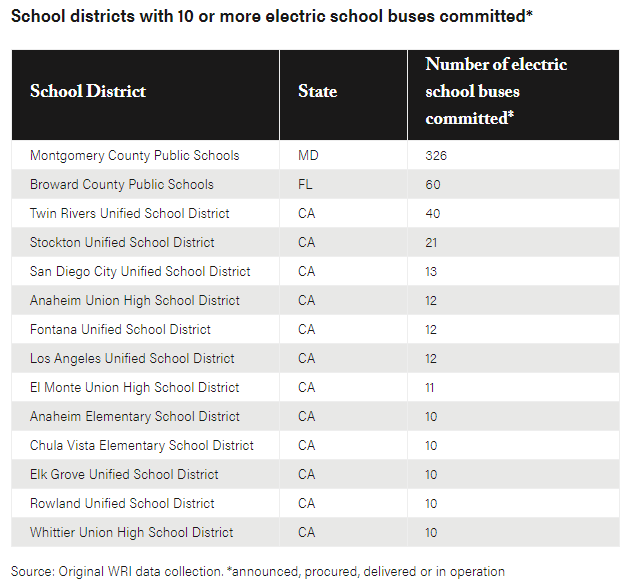
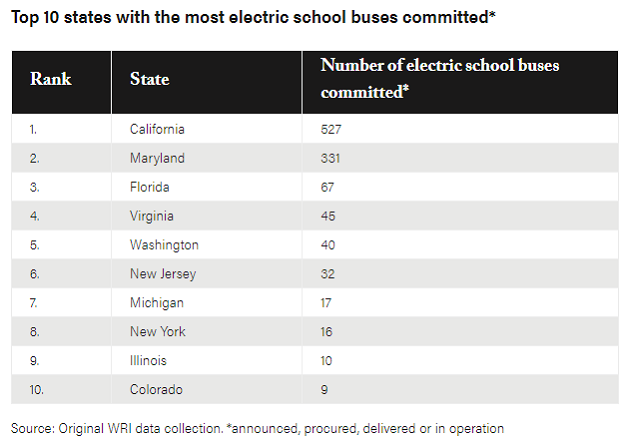
2. School Bus Electrification in Vulnerable Communities is Possible with Targeted Public Funding
Looking at school districts with at least one electric school bus committed, the largest share — roughly one third — are in the country’s top 25 per cent most vulnerable counties, according to the CDC’s Social Vulnerability Index, which incorporates factors such as poverty and lack of access to transportation.
Looking at the buses themselves, roughly one quarter of committed electric school buses are in the top 25% most vulnerable counties, and another quarter are in counties in the second quartile of vulnerability. WRI will soon publish additional analysis on the distribution of electric school buses in correlation with a wider range of equity-related indicators, including income, race and exposure to air pollution.
As noted above, California’s high number of electric school buses is primarily due to supportive state funding programs, many of which focus on areas with high air pollution, which also tend to have higher levels of social vulnerability.
However, if you exclude Californian school districts (by unchecking the box next to “Pacific” in the following two charts), the breakdown changes dramatically, with just a small fraction of school districts with electric buses located in the most vulnerable areas.
This reinforces the importance of emphasizing equity in school bus electrification programs and policies. A top priority is setting aside funds for disadvantaged school districts — including those serving low-income communities, communities of color, indigenous communities, and communities facing disproportionate air pollution — and providing them with funding for associated costs like charging infrastructure, technical assistance, and workforce investments as well as the buses themselves.
Additionally, the process of applying for and receiving funds should be streamlined, including assistance to reduce administrative burdens, so school districts do not have to assume upfront costs to apply or procure buses.
In the legend, click the colored tile next to each census division to remove or add it in the chart. Hover your cursor over the columns in the chart to see which states are included in each census division.
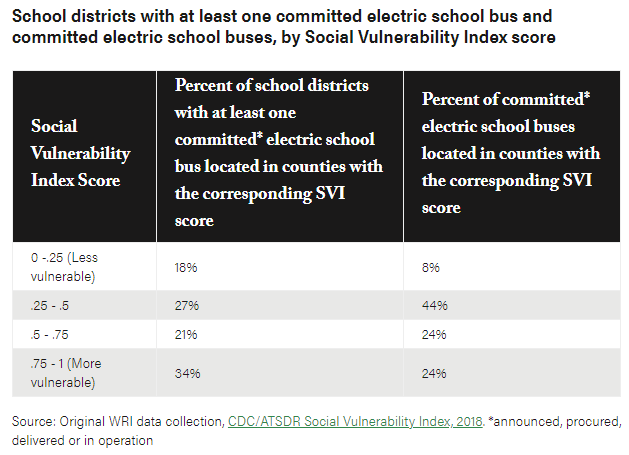
3. Most Committed Electric School Buses are in Suburban Areas
The largest share of school districts with at least one electric school bus are in suburban areas (36%), followed by cities (30 per cent). Seventeen per cent of both towns and rural areas have begun the shift to electric school buses. This roughly corresponds to those locales’ share of enrollment: of all the country’s elementary and secondary school students, 40 per cent are in suburban areas, 30 per cent are in cities, 19 per cent are in rural areas, and 11 per cent are in towns.
When looking at the distribution of the electric buses themselves, however, gaps start to emerge. Two thirds of all committed* buses are in suburban areas, with roughly a quarter in cities, and just seven per cent and six per cent in towns and rural areas, respectively.
These trends may reflect a shortage of funding or capacity in more rural areas, and more research is needed to explore these patterns and their equity implications. While concerns about the buses’ range have been suggested as a reason, manufacturers say that today’s electric school buses have the range to serve 90% of routes in the U.S.
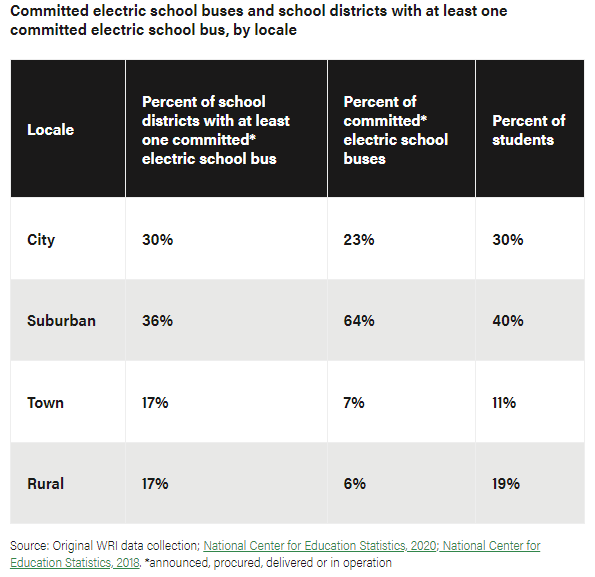
A Rare Opportunity to Scale up Deployment
Today, the major federal infrastructure investments being proposed offer a rare opportunity to catalyze the deployment of electric school buses.
President Biden’s American Jobs Plan proposes $20 billion to electrify at least 20 per cent of school buses through the Environmental Protection Agency’s new Clean Buses for Kids Program. And, demonstrating electric school buses’ broad appeal, the Bipartisan Infrastructure Framework includes $2.5 billion for school districts and other eligible entities to purchase electric school buses and charging infrastructure, with low-income and rural communities to be prioritized — both important steps in the right direction.
However, the bill also includes $2.5 billion allocated for either electric or “clean” alternative fuel school buses. These include buses powered by fossil fuels like natural gas or propane. Funding anything other than electric buses fails to advance our goal of decarbonizing all U.S. transit in order to meet our climate commitments, foster racial equity, and redress historic injustices.
Together with Congress and the Biden administration, states, cities, utilities, manufacturers and others have an opportunity to deploy electric school buses nationwide, ensure that disadvantaged communities are prioritised, and deliver children in the U.S. to school healthy and ready to learn.
Republished courtesy of TheCityFix
This article was originally published on WRI’s Insights.
Leah Lazer is Research Analyst II on WRI’s International Climate team.
Lydia Freehafer is Research Assistant for NUMO, the New Urban Mobility alliance, hosted by WRI Ross Center for Sustainable Cities.
Jillian Neuberger is Legislative Engagement Associate at World Resources Institute.
Jesse Worker is Senior Associate with the Environmental Democracy Practice in WRI’s Center for Equitable Development.
Data visualizations by Rosie Ettenheim


